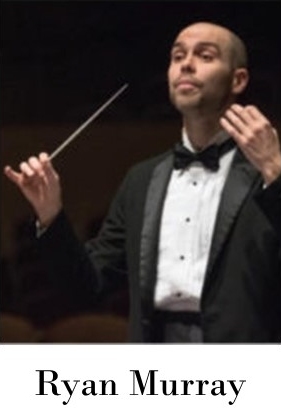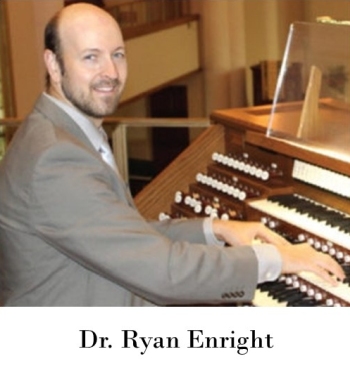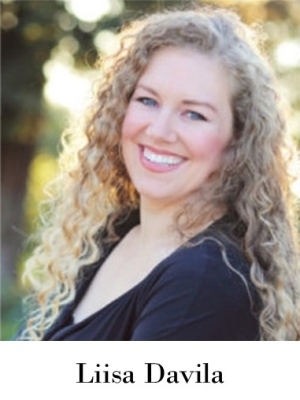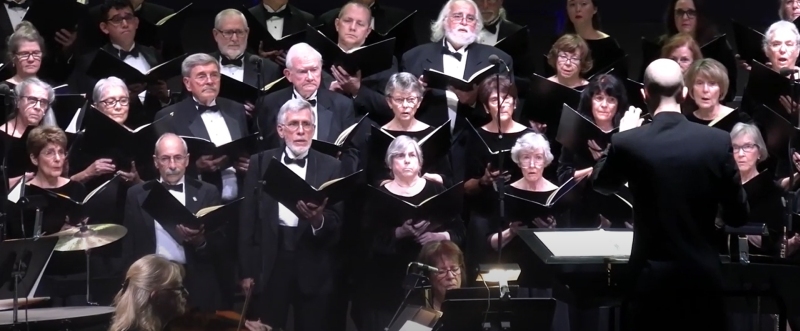Choral Review
Music in the Mountains
Requiem for the Living - November 7, 2021
(Special note: You can see a video recording of the entire concert at this YouTube link ─ https://www.youtube.com/watch?v=j266r7pts84. It was originally scheduled to be available only from Thanksgiving Day through Sunday, November 28. It is available Wednesday, December 1, but there is no guarantee how long it will continue to be available.)
November 7, 2021 was a big day for Music in the Mountains (MIM): their first choral/orchestral concert since Christmas 2019. Adding to the significance of this event was the venue, the recently renovated Center for the Arts on Main Street in downtown Grass Valley. I was fortunate to be present for this momentous Sunday afternoon performance.
To enter the Center, we had to show proof of vaccination (or evidence
of a negative Covid test), and once inside, everyone was required to be
masked. Having arrived early, I was able to look around. Besides the
performance space, there is a gallery with permanent and touring art
exhibits, a bar, and facilities for arts education. The performance
space itself can accommodate seating for up to 492: fixed stadium
seating, plus temporary seating on an open floor. This afternoon, the
floor seating was arranged with tables, and I would guess the eventual
near-sell-out crowd to have numbered about 300.
About one-third of the audience attended the pre-concert talk, which was given by MIM’s Artistic Director & Conductor, Ryan Murray, and soprano soloist, Liisa Davila. Murray gave us background on the guest soloists, and he previewed the works to be performed, deferring to Davila to describe her part of the program. I’ve heard Murray’s informative pre-concert talks before, and there was no way I would miss this one.
(Click here to open the concert program in a new window.)
At concert time, the lights dimmed, and MIM’s Executive Director, Jenny Darlington-Person came out to greet the audience. Her enthusiasm for this afternoon’s event was evident as she began, “It’s really amazing to see you” ─ not because of the size or composition of the audience, but because it was the first live audience for a Music in the Mountains ensemble in two years. She reminded us that the concert was dedicated to the loss of two people close to the organization (see the linked program). And with all the losses due to the pandemic (people, opportunities, companionship), this concert was “comfort food for the soul.” She even warned us that the beautiful music we were to hear might make us cry.
Ms. Darlington-Person went on to note that the chorus were all vaccinated and were tested the previous day. This was to explain why they would not be wearing masks when singing (though they eventually entered with masks in place). She then thanked the underwriters and sponsors (see the program).
I have to take a moment to congratulate MIM for providing the program
in advance by e-mail and having QR codes displayed throughout the Center
for the Arts so that people who hadn’t already done so could download
the program to their phones. Not just the titles and composers of the
music to be performed, but also the program notes and bios need to be
reviewed before arriving at a concert venue
─ or they may never be reviewed at all. And if you haven’t done
so, please consider reviewing the biographies of the three consummate
professionals in this afternoon’s concert: Conductor Ryan Murray,
organist Dr. Ryan Enright, and soprano Liisa
 Davila.
Davila.
Dr. Ryan Enright, Organist
Well-known in the Sacramento music community as a brilliant organist (and pianist), Dr. Ryan Enright entered the stage to begin the concert. Since his selections were not described in the program notes, he gave us a preview of the three pieces he would be performing. They were compositions of increasing complexity and sophistication, starting with “Prelude” (from Twelve Pieces, op. 58) by Canadian composer, Rachel Laurin. Most of us in the audience were at a considerable distance from the stage, and the organ was pointed more or less stage right. But fortunately for us, there were monitors on either side of the stage that allowed us to watch Enright’s hands on the manuals and his feet on the pedal board.
I’m not competent to truly evaluate the performance of an artist like Dr. Enright but, from the start, I felt I could hear the evidence of years of refinement in technique in the precision of the sixteenth-note phrases in “Prelude.” Then in Laurin’s “Fuga seriosa,” there was the expressive yet completely controlled recurrence of the fugue statement. At the completion of this piece, the audience was confused whether to applaud, but they did so enthusiastically when Enright slid off the organ bench to offer some comments about the next piece.
“Fête” by Jean Langlais was exciting, driving music from the
beginning. Enright explained it as incorporating improvisation, and he
suggested that it was an expression of repressed emotion after the end
of the Nazi occupation of France. (The piece was written in 1946.) It
might have been hard to listen to until you changed your expectations to
appreciate the extraordinary virtuosity of composer and performer and
feel the energy and joy of an uninhibited musical celebration. To me, it
felt like one long cadenza. There certainly must have been improvising
in the furious pace of this piece, because it’s hard for me to imagine
all those notes on a printed page. At its conclusion, I heard a “wow”
behind me, accompanied by enthusiastic applause from the audience.
Soprano Liisa Davila
Next on the program was Sacramento-based soprano, Liisa Davila. Since her selections were not covered in the program notes, she, too, gave us some very helpful background on what she would be performing. Both of her first two selections were by 19th century Italian composer, Paolo Tosti. The first was “Aprile,” an appreciation of the delights of the month of April. In her pre-performance comments, Davila noted that “A singer gets to sing out her feelings.” Indeed, as she sang, I saw those feelings expressed as she exulted in the beauty of nature. Her voice was unforced, and the serenity of her facial expression and her unstudied arm movements combined with true vocal artistry to make you believe that her appreciation of the delights of April was honest.
Before beginning the next piece by Tosti (please see the program for the long title), Davila commented that this was her first opportunity to perform with solo harp accompaniment, and I have to add that the playing by harpist, KIerstin Allvin was exquisite. Indeed, the combination of Davila’s clear voice and the delicate sounds of the harp were transporting. If I had such a duet on a CD, I’d play it over and over. This next piece, though, for all the beauty of the music, had a dark theme, and now Davila was expressing despair to the point that she wiped away a tear at its conclusion (though she tried to blame the tear on the lights). After she ended with a beautiful diminuendo, there were “wows” from the audience, accompanied by sighs of appreciation and enthusiastic applause.
Davila’s introductions to her songs were given with a sunny disposition ─ thoughtful attempts to guide the audience’s expectations. And this continued to be true for Mozart’s “Exultate Jubilate,” which was accompanied by Dr. Enright at the organ. Interestingly, the song had a single lyric, the word, “alleluia.” She sang this from memory (as she had her other selections), and surely it was quite a feat to remember which “alleluia” phrase came where. But the virtue of a professional singer (or organist, or harpist, or conductor) is making their performance seem effortless ─ which Davila did. The difficult arpeggios were delivered with a smile that made it pleasant to watch her as she ended on an impossibly high note. Then the two accomplished professionals took their bows as many in the audience rose to their feet as they applauded.
Requiem for the Living
After a lengthy intermission, the 53-member Music in the Mountains
Chorus filed onto the risers, wearing masks (which they removed before
singing). Artistic Director & Conductor, Ryan Murray (accompanied by
Davila and Enright) then entered to welcoming applause. With Murray’s
pre-concert talk still fresh in my mind, I once again appreciated the
articulateness with which he explained the concept and structure of Dan
Forrest’s Requiem for the Living. To briefly summarize, Murray
noted that unlike the traditional requiem, this one was for the
consolation of the living since “music is a partner in life for this
journey [that we all are on].” To understand what we in the audience
heard and felt, I urge you to read the well-written program notes for
the Requiem.

The “Introit and Kyrie” (the first of 5 movements) started with a single sustained note from the organ, followed by a single note from the cello. As the ensemble built, I was instantly appreciative of the sparse orchestration: organ, harp, oboe, cello, violin, flute and percussion. With a single player on each instrument, I felt special appreciation for their contribution to the ensemble. The sensitive entrance of the chorus matched the lyrical quality of the music, and I was a little surprised that the sound seemed so balanced since there were (as is often the case) twice as many women as men. Eventually, there was the explosion of their first fortissimo, which I found thrilling ─ as thrilling as the controlled diminuendo at the close of this movement. The effort of the orchestra and chorus made this first movement pure listening pleasure for each of us in the audience.
The second movement, “Vanitas Vanitatum” (“vanity of vanities”) was agitated, with unusual rhythms and terse lyrics, and it put us in the audience on the edges of our seats. As a former choral singer, I appreciated the intense effort required of the chorus to spit out the words and watch the rests carefully. And I think my fellow audience members were similarly impressed.
As the “Agnus Dei” movement began, I noticed the open mouths of the singers working to project their sound, while articulating the consonant-heavy sections (“qui tollis peccata mundi”). The many moments of marcato and staccato singing captured our attention, setting up the contrast to the “dona nobis” text with the soprano solo accompanied by harp and flute. Davila delivered this section with rich, heartfelt singing, marked with a noticeable air of serenity that was presently matched by the singers on the risers. There were many moments in this movement when I felt that the chorus (and orchestra and soloist) performed with ineffable expressiveness, conveying a message of great comfort. I think it must have felt as cathartic to them as it did to many of us in the audience.
The text of the “Sanctus” movement included the Latin for “heaven and earth are full of Thy glory,” and this sentiment was illustrated by images of space taken by the Hubble Space Telescope, plus images of scenes on earth ─ all displayed on the screens on either side of the stage. Forrest has explained that he was actually thinking about the Hubble Telescope’s window on the immensity of space when he was writing this music.
The culmination of this musical and spiritual journey was the calm and peacefulness of the “Lux Aeterna” movement in which there was a beautiful segment where the chorus and soprano sang a cappella. Then while we in the audience were feeling embraced by the warm choral sound and its support by the orchestra, we were given the only text in English: “Come unto me, all ye who labor and are heavy laden, and I will give you rest” (Matt 11:28). This was sung to great effect by tenor Matt Hidalgo from his position among the chorus. Hidalgo is well known for his many solo appearances in the Sacramento region.
By the end of “Lux Aeterna,” we surely felt metaphorically bathed in light, and in a moment everyone was on their feet, applauding in appreciation. We had been hungry for this choral concert, studded with excellent solo performers, coming after such a long fast. All of us on our feet felt we had been given a magnificent meal to end that fast.
Please note the following websites (click to open in a new window): Music in the Mountains, Ryan Murray, Liisa Davila, and Dr. Ryan Enright.
Dick Frantzreb is editor of the Capital Region Performance Gallery. He also edits the Sacramento Choral Calendar and the Placer Performance Calendar, and he was a co-founder and past President of the Sacramento Valley Choral Coalition. He has been loving live performances in the greater Sacramento area and writing about them since 2012.